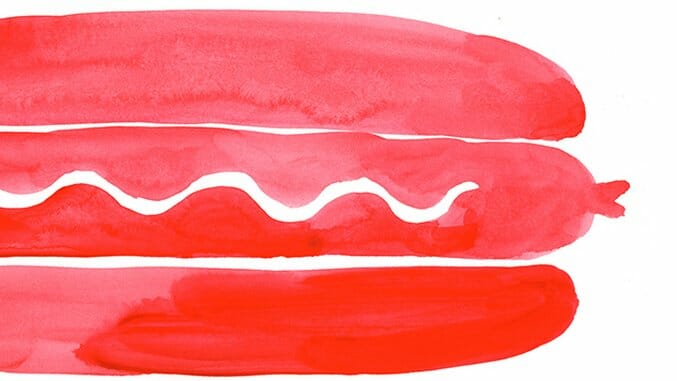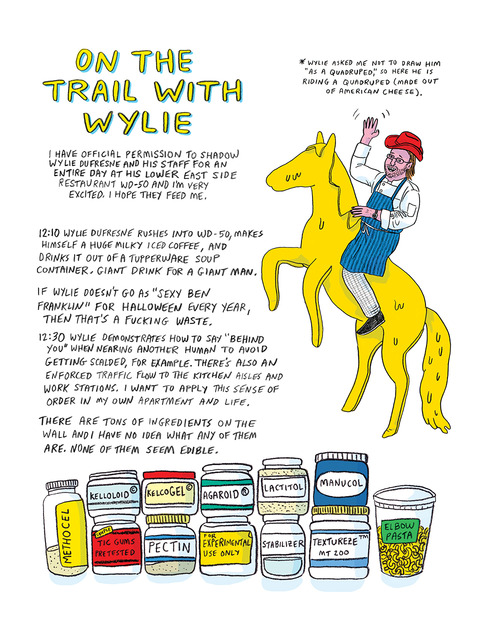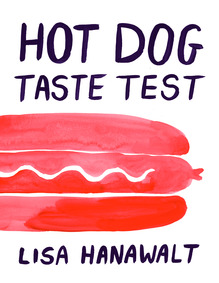BoJack Horseman Designer Lisa Hanawalt on Eating Animals, Drawing Animals and Her Hot Dog Taste Test
Comics Features BoJack Horseman
Cartoonist and journalist Lisa Hanawalt keeps busy: she’s the production designer/producer of the Hollywood-pondering Netflix series, BoJack Horseman; co-host of the intentionally random comedy podcast, Baby Geniuses; a James Beard Award-winning humorist; and an ultra-talented creator of sharply humorous comics. In her new comic collection, Hot Dog Taste Test (out this week from Drawn & Quarterly), Hanawalt revels in the oddities of food, pop culture and all manner of non-sequitur through her quirky blend of humor and art.
The graphic novel is playful and punny in its dissection of late-20-something impermanence, and will also hit you in the feels. Every re-read of Hanawalt’s work proves more rewarding: new details emerge from overlooked scenes, or her dreamy watercolor palettes shimmer with renewed appreciation. Although she does many things (yes, we covered this a paragraph before), Hanawalt’s work resonates the most powerfully when she reveals herself in her words and anecdotes, deftly exploring the discomforts, confusions and hilarities of life, and helping us see just how wonderfully weird our little world can be. Paste emailed with Lisa to discuss food, art and the mysterious chicken bones that line New York City. ![]()
Paste: You create art through textiles and sculpture, co-host a podcast and are the production designer/producer of BoJack Horseman—can you talk about the ways different creative channels allow you to express yourself?
Lisa Hanawalt: I think I just get bored easily! I like trying new things, and I feel best about myself if I’m not limited to one creative outlet. And this way if I’m feeling burnt out on drawing, I can switch my energy to writing or sculpting for awhile.
Paste: Some of the pieces in Hot Dog Taste Test come from your column in Lucky Peach magazine. How did that collaboration come about? What is your own relationship with food and eating—are you a foodie (sorry, we have to collectively come up with a better word for this yet), or more of a pragmatic “I-am-hungry-so-I-will-eat-a-thing-and-then-not-be-hungry-anymore” eater?
Hanawalt: The first time I was in Lucky Peach, I’d pitched an idea for a comic about The Secret Lives of Chefs, then about a year later I was asked to be a regular contributor. It’s always fun working with the editor, Peter Meehan, to come up with ideas that fit with their themes (each issue revolves around a specific topic, like “breakfast” or “obsession”). Part of the fun is seeing how loosely related to food my pieces can get.
I haven’t thought too much about the word “foodie,” but I definitely lie closer to the “I just need to eat a thing to fuel myself” end of the spectrum. It’s not quite a hobby, I don’t feel a need to try all the newest restaurants. But if Jonathan Gold writes about some hole-in-the-wall with a spicy soup, I’ll get excited to go try it.
Paste: In one of your illustrations, you spend a day following renowned chef Wylie Dufresne. What were the most surprising or interesting things you learned about the world of a chef during that experience? Did it change your relationship to food and eating in any way?
Hanawalt: I didn’t fully realize what a physically taxing job being a chef is; the fact that Wylie and his colleagues were all dealing with painful back problems was sobering. I already knew a bit about molecular gastronomy before going, but the meal I ate at wd~50 was legitimately the most inventive food I’ve had. Very playful.

Hot Dog Taste Test Interior Art by Lisa Hanawalt
Paste: You’ve mentioned that having a role as a “food reporter” and speaking to people in the context of a job helped ease your struggles with anxiety and agoraphobia. Was that an unexpected outcome, or had having an assigned role to play in a social situation helped with that before?
Hanawalt: That was definitely part of the appeal of doing these pieces. I think that even at my most anxious, if I have a job to do or a role to fill, I know on some level I can step up and complete it. I mean, I’m probably not going to go bungee jumping anytime soon…but pushing myself to weather some discomfort now and then feels healthy.
Paste: Some illustrations in your new book explore family traditions, including during holidays. Is food at the centerpiece of any traditions in your family? Are there are any comfort dishes from your family and/or childhood?
Hanawalt: My family always ate dinner at the table and we would chat about our day while eating. My parents like to have a few glasses of wine and linger after the meal is over, peeling oranges for dessert while talking. It’s lovely.
My mom used to make a lot of quiche, Spanish omelettes and milanesa. Occasionally my dad would cook up a hearty beef stroganoff. Super comforting.
Paste: As a New Yorker, I loved following the depictions of your food-ventures around the city (and that chicken bones made an appearance in one—why are there so many chicken bones all over the streets of NYC?!). Now that you live in LA, is there an NYC food experience you miss most? And do you have a favorite food experience in your new home city, LA?
Hanawalt: I miss the density of New York City more than anything else. It was loud and overwhelming (and covered in bones!), but I’d walk past so many options for food every day. My partner and I lived in the East Village for six months and we were right across the street from a Momofuku, around the corner from a great shabu place, and down the street from Salvadoran takeout…
In LA, my favorite is driving out to San Gabriel (not thaaat far from Echo Park) for Szechuan food, getting pork neck stew in Koreatown, and getting tacos from trucks late at night. It’s also easy to get a really decent, fresh salad here, as boring as that sounds. LA is my favorite town to eat in.
Paste: In the comic “Caballos Con Carne,” the main character explores the experience of loving and valuing animals, but also eating them. Is that a dichotomy you wrestle with?

Lisa Hanawalt Portrait by Jean Ho
Hanawalt: Absolutely. I’m not a vegetarian, but while I don’t want to defend it, I try to be mindful about the amount of animal products I consume. I eat a lot of vegan meals at home, and I’m okay with paying more for higher quality meat and eggs, as a tax.
Am I occasionally going to eat some lower quality meat if I’m at a taco truck? At the moment, yes. I might later decide that this level of cognitive dissonance is too shitty to stick with.
Paste: Illustrations in Hot Dog Taste Test find you exploring themes of death and family—are these things you’ve always thought about, or find yourself thinking about more as you grow older?
Hanawalt: I’ve always worried about death a lot. I think my relationship to it has changed a little as I’ve gotten older and more people close to me have passed away. But yeah, I worry a lot! I’m overprotective. I’d just like everyone close to me to stick around for 50 more years at least, doesn’t that seem reasonable?
Paste: You’ve spoken openly about your work being very personal to you, and often emblematic of a problem you’re working through in your life. How do you decide what to illustrate and what not to? Are there some things that feel too personal to share, or does exploring personal and challenging things in your life help you work through them?
Hanawalt: Certainly exploring those difficult things feels cathartic, but if it feels too personal I just mask it by burying my experience in a fictional story, with animal characters. The Argentina travel diaries in my book are an exception—there’s some difficult stuff in there, mixed in with the silly.
Paste: It’s no secret that you love horses; can you talk more about why or how you decide to illustrate the other animals in your stories? How do you decide which animal will be right for a situation, especially when an animal portrays something you are personally going through?
Hanawalt: This is weird but I can’t think of a time when I wondered what kind of animal a character should be! It always happens so organically. Tuca had to be a toucan; the character came to me at the same moment as the idea of drawing a toucan. The couple in my comic “Planting” were always going to be little birds, from the moment that story first popped into my head.
Paste: I really enjoyed your snapshots of female life through the characters Bertie and Tuca. Is exploring female struggles, even lighthearted ones, something you are focused on as an artist, or something that happens naturally?
Hanawalt: It happens naturally now. When I was younger, I think I internalized some bullshit about female-focused stories not being as valuable as male ones. I thought only men got to be funny and do gross or exciting stuff, because that was true of every television show I was watching, and almost every book I was reading. I’m glad I grew out of that mindset, because I have a lot of funny, gross, exciting and sad stories I want to tell from my (female) perspective.
